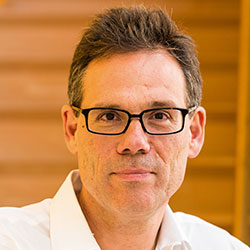
About
Dr. Fee was appointed head of the department in 2021. He joined BCS in 2003 and is currently the Glen V. and Phyllis F. Dorflinger Professor and an Investigator in the McGovern Institute. He received his PhD in Applied Physics from Stanford University in 1992. Before moving to MIT, he was a principal investigator in the Biological Computation Research Department at Bell Laboratories in New Jersey.
Research
The research in the Fee Lab has two main themes:
- To understand the neural and biophysical mechanisms underlying the generation and learning of complex sequences
- To develop advanced optical and electrical techniques for measurement of brain activity in behaving animals.
We study how the brain learns and generates sequential behaviors, with a focus on the songbird as a model system. We are currently trying to understand how circuitry in two forebrain nuclei, RA and HVC, produce the complex sequence of vocal/motor gestures that comprise the song. We have recently found neurons in nucleus HVC that generate only a single brief burst in the sequence, and may form an explicit representation of time in the brain. Young songbirds learn their song by imitating a tutor. Young birds start by babbling, just as humans do, and gradually refine their highly variable juvenile songs to produce a good copy of the adult song. We are trying to understand the brain mechanisms that underlie this vocal imitation, and are focusing on a model called reinforcement learning. Reinforcement learning would suggest that the bird learns its song by ‘trial-and-error' search for the pattern of control parameters that will produce the correct song. We are currently exploring the neural origin of this ‘trial-and-error' search, and have identified a brain area that may be responsible for generating this creative vocal exploration. We are also interested in developing advanced techniques for recording electrical and optical signals from neurons in behaving animals. Recently developed techniques include a 1.5 gram motorized microdrive for chronic recording, an active electrode stabilizer for intracellular recording in awake animals, and a miniature two-photon microscope for intracellular imaging in freely behaving animals.
Publications
Mackevicius EL, Gu S, Denisenko NI, Fee MS. Self-organization of songbird neural sequences during social isolation. Elife. 2023 May 30;12:e77262. doi: 10.7554/eLife.77262.
Scherrer JR, Lynch GF, Zhang JJ, Fee MS. An optical design enabling lightweight and large field-of-view head-mounted microscopes. Nat Methods. 2023 Apr;20(4):546-549. doi: 10.1038/s41592-023-01806-1. Epub 2023 Mar 16. PMID: 36928075
Mackevicius EL, Bahle AH, Williams AH, Gu S, Denisenko NI, Goldman MS, Fee MS. Unsupervised discovery of temporal sequences in high-dimensional datasets, with applications to neuroscience. Elife. 2019 Feb 5;8. pii: e38471. doi: 10.7554/eLife.38471.
Lynch GF, Okubo TS, Hanuschkin A, Hahnloser RH, Fee MS. Rhythmic Continuous-Time Coding in the Songbird Analog of Vocal Motor Cortex. Neuron. 2016 May 18;90(4):877-92. doi: 10.1016/j.neuron.2016.04.021.
Okubo TS, Mackevicius EL, Payne HL, Lynch GF, Fee MS. Growth and splitting of neural sequences in songbird vocal development. Nature. 2015 Dec 17;528(7582):352-7. doi: 10.1038/nature15741. Epub 2015 Nov 30.
Goldberg JH, Fee MS. A cortical motor nucleus drives the basal ganglia-recipient thalamus in singing birds. Nat Neurosci. 2012 Feb 12;15(4):620-7. doi: 10.1038/nn.3047.
Fee MS, Goldberg JH. A hypothesis for basal ganglia-dependent reinforcement learning in the songbird. Neuroscience. 2011 Dec 15;198:152-70. doi: 10.1016/j.neuroscience.2011.09.069. Epub 2011 Oct 13. Review. Erratum in: Neuroscience. 2013 Dec 26;255:301.

